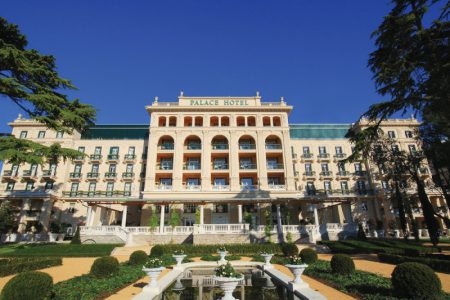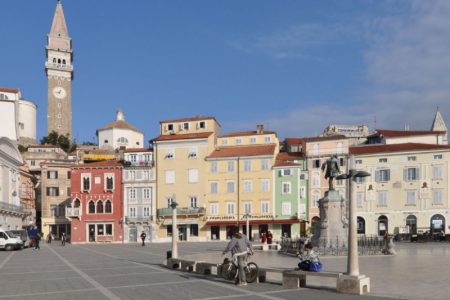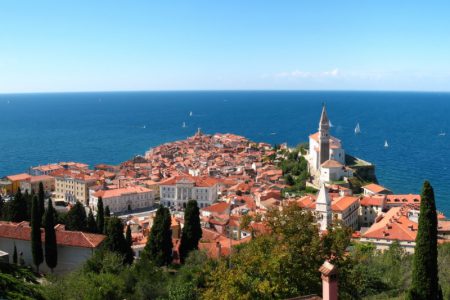Piran & Portoroz Guide
Piran and Portorož, two towns on Slovenia’s short Adriatic coast, could hardly be more different. Picturesque Piran, known as Pirano to Italians, charms visitors with its narrow old streets of medieval houses, while Portorož – the name means ‘port of roses’ – is a modern, upmarket coastal resort known for its exclusive hotels, health spas and lively nightlife. They are, however, just a short distance apart, giving visitors the best of both worlds.
Piran has a distinctly Italian feel and not just because it was once part of the Venetian empire. All of this region was once part of Italy and even today a significant Italian minority means that Italian is an official language so you’re as likely to be greeted with a ‘Ciao’ as you are a ‘Dober dan’. Many Italians like to hop over the border for lunch and if Italians come for the food, it must be good. The harbour-side area has a dozen or so excellent restaurants, all of which have great views; fish dishes dominate the menus but Balkan grill specialties are also popular and the ice cream is out of this world.
It was salt, not fish, that created the fortunes of medieval Piran. The Venetians had established dominance in the northern part of the Adriatic by negotiating trade agreements with other cities, which would allow those cities to remain independent while giving the Venetians access to the manufactured goods and raw materials they needed. The supply of salt, however, was something that the Venetians wanted to control for themselves and after a short war in 1282 they took control of the salt flats of Piran. The Sečovlje salt-works are still active but they operate within the Sečovlje Salina Nature Park which was established to protect not only the industrial heritage of the salt flats but also the flora and fauna that have made a home in the abandoned parts of the salt pans. Piranske Soline is a highly regarded brand which is starting to make an impression with international chefs and restaurateurs; the products are now sold in Harrods of London and used in Jamie Oliver’s chain of Italian restaurants. The mud, which is a by-product of the salt extraction process, is used in therapeutic treatments in some of the spas of Portorož.
Other points of interest include the old city walls, St. George’s Cathedral, the Franciscan church and monastery and the Sergej Mašera Museum which covers all things maritime. While all of these attractions have long opening hours during the summer months, many have shorter opening hours during the winter, or may admit visitors only by appointment.
Life in Piran revolves around Tartinijev trg (Tartini Square), named after Giuseppe Tartini, the Italian composer who was born in a house on the eastern side of the square in 1692. Since 2001 an annual classical music festival, named after Tartini, has been held in venues across the town. There’s a monument to Tartini on the square, and an exhibition on the composer and his work can be visited on the first floor of the house he was born in. Now traffic free, Tartinijev trg is the hub of Piran’s cafe culture and there can hardly be a more scenic spot to settle down for a coffee and some people watching.
Music features heavily in the local cultural calendar, one of the highlights being the MIFF Folklore Festival which has taken place each July since 2003. The event brings in dancers, musicians and story tellers from other southern European countries for performances in Piran’s Tartinijev trg and venues in Izola and Koper. The town also has an annual antiques fair and several fine arts events.
In summer Piran’s quaint streets are filled with tourists. Some come on half day trips from cruise ships docked at nearby Koper while others come down from Ljubljana or the mountain resorts around Bled. Accommodation in Piran itself is quite limited though there are several good hotels, but many tourists opt to stay in Portorož where there is more choice. Although there are many more hotels rooms in Portorož, the resort is a popular destination for conferences and the town plays host to a number of high profile international events so advance booking is advisable.
With its palm-lined promenade and sandy beach, Portorož can hold its own against any seaside resort in southern Europe; if you’re looking for somewhere to bask in the sun Portorož is a perfectly good place, though money talks and the steady influx of wealthy tourists who come to sun themselves at Portorož have caused prices to rise. Portorož may not have the historical charm of Piran but what it does have is mud and thermal waters and it was thanks to these that the town rose to prominence as a health tourism destination in the nineteenth century.
World Wars I and II saw a decline in the fortunes of the town, which lasted until the late 1960s; in 1968 a regeneration project was launched which resulted in the building of vast modern hotels. More recently some of the town’s elegant nineteenth century villas have been renovated to become boutique hotels. In its heyday the Kempinski Palace accommodated the wealthy Hapsburgs who came to have the Portorož spa treatment. Now extravagantly refurbished, the hotel is once again the talk of the town. With at least six spa centres, Portorož is still a popular destination for holiday makers seeking some pampering. Cream of the crop is the Paradise Spa within the Grand Hotel Bernardin which is open to day visitors as well as hotel residents.
Portorož is a great destination for people seeking an active holiday. There are numerous opportunities for water-sports, cycling and horse riding, and Portorož Airport can organise tandem parachute jumps or panoramic flights which are perfect for adrenaline seekers. Nemo Divers, based in Portorož, is among several companies offering PADI training and diving trips.
One of the highlights of the Portorož calendar is the Internautica International Boat Show; it features a huge display of the latest boats on the market and attracts more than 250 specialist exhibitors. With a varied programme of entertainment, its audience is not only the well-heeled yachting set: in fact, almost 15,000 people attended the event in 2013. The annual Slovenian Film Festival, a four day event, sees director, critics, actor and movie buffs descend on Portorož for a series of film showings and seminars, and a whole lot of networking.
Since 1961 an international symposium on sculpture has taken place every two years in Portorož (or, more precisely, Seča, a village just outside the town); Forma Viva invites sculptors from all over the world to create pieces especially for the show. The new works remain in situ when the symposium closes and there are now over 120 pieces at Seča and nearby in parks in Piran, Koper and Izola. While Forma Viva Portorož consists of sculptures made of stone, other Forma Viva parks in Maribor, Kostanjevica na Krki and Ravne na Koroškem feature sculptures made from concrete, wood and metal respectively.
The Slovenian Open Tennis tournament takes place in Portorož each year and attracts some well-known names. In 2013 the tournament was won by Slovenian Grega Žemlja, hot on the heels of his impressive showing at Wimbledon where he became the first Slovene player to reach the third round.
Portorož International Airport does not currently have any scheduled flights but Slovenia’s coast is easily accessible from Ljubljana thanks to a recently completed highway which has dramatically reduced journey times. Trieste Airport is just sixty kilometres from Portorož and Croatia’s Pula Airport also has connections to a number of European cities.
Popular attractions such as the Lipica Stud Farm, home to the world famous Lipizzaner horses used at the Spanish Riding School in Vienna, and the stunning show-caves at Postojna are within easy reach and can be visited independently or on organised tours. Venice is a short hop across the Adriatic and many local operators sell day trips. For a quieter, more authentic experience, the Istrian hinterland is studded with pretty villages: Padna is one of the most picturesque. Surrounded by olive groves this little village became prosperous thanks to the skills of its farmers who supplied the coastal towns with oil, meat and vegetables; in fact, the famers of Padna sold so much excellent chard that it financed the building of the handsome church tower of St. Blaž.
Property in this region ranges from purpose built apartments through charming stone cottages and farmhouses to luxury villas. Coastal daytime temperatures between May and September average between 20-25°C (but often exceed this) and winters tend to be much milder than inland. Good connections with Ljubljana, Croatia and northern Italy and onwards to Austria make Slovenia’s coastal region a realistic option for re-location. As a result the real estate scene here can be fast moving. Nearby Koper, a busy port city, is the commercial centre for the region and is the hub of the University of Primorska which has more than five thousand students.
You can read more about the potential for investing in Piran Property and also view the Best Properties in the region on our website. If you have any questions or queries on buying or selling a Piran real estate please contact us at any time and we will be delighted to help.














